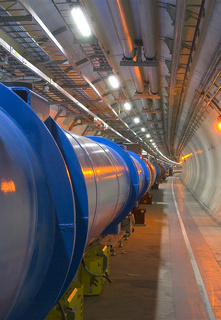Sep 10 2008
When protons are accelerated to almost light speed in CERN's LHC - or Large Hadron Collider's underground circuit near Geneva for the first time today, the Linde cooling systems installed there will also experience their first assignment.
 CERN’s LHC (Large Hadron Collider) underground circuit near Geneva. It is installed in a ring tunnel of 27 km perimeter, 100 m below the earth’s surface. Image courtesy of CERN.
CERN’s LHC (Large Hadron Collider) underground circuit near Geneva. It is installed in a ring tunnel of 27 km perimeter, 100 m below the earth’s surface. Image courtesy of CERN.
"We are pleased to be able to contribute our expertise to this unique, fundamental research project" said Dr. Aldo Belloni, member of the Executive Board of Linde AG. "Just like the LHC as a whole, the technology we have implemented sets new standards. After years of planning and preparation, we are now glad that we can make our contribution toward the attainment of new scientific insights."
Extremely strong magnetic fields are required to keep the high-energy protons on their 27km circuit. These magnets and the accelerator's cavities are cooled by eight high-performance cooling systems distributed on the circuit's periphery. Each of the eight cooling systems is allocated one multi-stage cold compression system, each of which is installed in a separate cold box, and which reduces the temperature of the magnets to 1.8 degrees Kelvin (-271 degrees Celsius). Only helium - the coldest liquid in the world - is capable of achieving this. Only the superconductivity that occurs in the magnetic coils at such an extremely low temperature makes generation of the necessary magnetic field strength possible.
The helium chilling system was designed, constructed and installed by the Linde subsidiary, Linde Kryotechnik AG - whose headquarters are in Pfungen, Switzerland. Linde Kryotechnik AG was already awarded the 'Golden Hadron Award' by CERN in 2003 for its outstanding achievements. Operation and maintenance of the systems will be carried out by the Swiss cryogenic temperature experts in cooperation with two other companies in the consortium. Our specialist producers of the coldest liquids in the world provide a range of services, including systems for liquefying helium, hydrogen and neon - which are used in research, industry and medicine.
The actual experiments in the LHC consist of controlled proton collisions. Two clustered particle beams circulating in opposite directions are pushed toward each other in one of the four large detectors. By documenting the fission products thus generated, researchers hope to make fundamental new insights into the physical processes that took place during the big bang. They would also like to find evidence to support the currently only theoretical existence of exotic elementary particles, such as the Higgs boson, which allegedly gives matter its gravity.